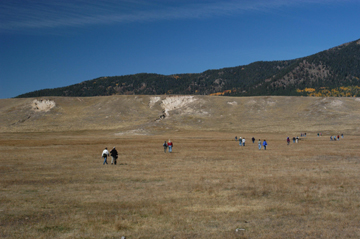Geotimes

Feature
Valles Caldera
Scientific Drilling
Fraser Goff and
Jeffrey M. Heikoop
 In the heart
of the Jemez volcanic field in northern New Mexico lies the 22-kilometer Valles
caldera — a beautiful example of a resurgent caldera. Now owned by the
U.S. government and known as the Valles Caldera National Preserve, this collapsed
volcanic crater is about 1.25 million years old and hosts a 280 degree-Celsius
liquid-dominated hydrothermal system.
In the heart
of the Jemez volcanic field in northern New Mexico lies the 22-kilometer Valles
caldera — a beautiful example of a resurgent caldera. Now owned by the
U.S. government and known as the Valles Caldera National Preserve, this collapsed
volcanic crater is about 1.25 million years old and hosts a 280 degree-Celsius
liquid-dominated hydrothermal system.
Workshop participants walk toward some
of the lacustrine deposits exposed in Valle San Antonio, Valles caldera. The
north caldera wall appears in the background. These deposits overlie a post-caldera
rhyolite dome sequence dated at 0.8 Ma. This section contains a rich assemblage
of diatom fossils and has normal magnetic polarity. Image courtesy of the authors.
Over the past 30 years, various drilling projects have revealed a fascinating
wealth of information on the geothermal potential of the caldera. Most recently,
65 U.S. scientists met in Los Alamos, N.M., to weigh the pros and cons of pursuing
more drilling in order to understand climate change history through intracaldera
sediments at this famous location. To learn more, visit www.geotimes.org.
Past efforts
Geothermal prospecting from 1960 to 1984 resulted in drilling of 24 deep exploration
and production wells but a commercial reservoir was never developed for many
reasons. From 1984 to 1988 the Continental Scientific Drilling Program drilled
three core holes in Valles that produced a wealth of published information on
the configuration of the hydrothermal system, the stratigraphy and structure
of the resurgent dome, and analogues with fossil ore deposits. The last hole
drilled was briefly the deepest, hottest core hole drilled in the conterminous
United States — at 1,762 meters and 295 degrees Celsius.
Valles caldera also contains little known lacustrine sediments and hydromagmatic
deposits dating from the inception of caldera formation to roughly 50, 000 years
ago. More recent bog deposits also exist. Presumably, many of these deposits
lie buried within the caldera moat, and are overlain and interbedded with post-caldera
moat rhyolite eruptions. New geologic mapping at 1:24,000 scale shows that the
best exposures of lacustrine rocks occur on the uplifted flanks of the central
resurgent dome and as eroded remnants within the encircling valleys (Valle Grande,
Valle Toledo, Valle San Antonio).
Very few absolute ages exist for these lacustrine deposits but geologic constraints
indicate that a large lake formed in the caldera immediately after its creation
and that several lakes existed in the valleys after 800,000 years ago. A 1952
pollen study by Paul Sears and Kathryn Clisby on shallow core and cuttings from
a water well drilled in Valle Grande shows pronounced cycles of "dry"
to "wet" pollen ratios that apparently mimic glacial-interglacial
climate cycles. Presumably, the sediments of this study represent the youngest
lacustrine deposits. Although nearly forgotten, this investigation suggests
that the caldera sediments may contain a significant climate record and indicates
that the Valles record correlates with a climate record as far away as Mexico
City.
Next step
Most participants at the October workshop felt that the lacustrine sequences
in Valles warranted further investigation before their climate change potential
could be fully appreciated. Although no consensus was reached, many people suggested
drilling a preliminary exploratory scoping corehole in Valle Grande to penetrate
the youngest lacustrine sequences and to investigate their climate record using
pollen, paleomagnetic, isotope, dating and other investigative techniques.
Many of the scientists also said that shallow seismic surveys were necessary
in Valle Grande to determine the thickness and structure of the moat sediments,
the position of possible buried volcanic domes, the absolute position of the
buried ring-fracture zone, and the most suitable drilling site(s) for shallow
and deep coring. Successful results from the scoping hole, they said, would
justify additional and deeper holes for further climate research at Valles.
Drilling and funding requirements for the scoping hole are being evaluated.
For additional information on the workshop, participants, and/or Valles lacustrine
deposits, contact the authors.
Goff and Heikoop are both geologists
at the Los Alamos National Laboratory in Los Alamos, N.M. Email: fraser@lanl.gov.
Link:
LANL
Web site on Valles Caldera drilling
References:
Goff, F., 2002, Geothermal potential of Valles Caldera, New Mexico. Geo-Heat
Center, Quarterly Bulletin, v. 23(4), p. 7-12.
Goff, F., and Gardner, J.N., 1994, Evolution of a mineralized geothermal system,
Valles caldera, New Mexico. Economic Geology, v. 89, p. 1803-1832.
Sears, P.B., and Clisby, K.H., 1952, Two long climate records. Science,
v. 116, p. 176-178.
Smith, R.L., and Bailey, R.A., 1968, Resurgent cauldrons: Geological Society
of America, Memoir 116, p. 613-662.
Back to top
 In the heart
of the Jemez volcanic field in northern New Mexico lies the 22-kilometer Valles
caldera — a beautiful example of a resurgent caldera. Now owned by the
U.S. government and known as the Valles Caldera National Preserve, this collapsed
volcanic crater is about 1.25 million years old and hosts a 280 degree-Celsius
liquid-dominated hydrothermal system.
In the heart
of the Jemez volcanic field in northern New Mexico lies the 22-kilometer Valles
caldera — a beautiful example of a resurgent caldera. Now owned by the
U.S. government and known as the Valles Caldera National Preserve, this collapsed
volcanic crater is about 1.25 million years old and hosts a 280 degree-Celsius
liquid-dominated hydrothermal system. 
